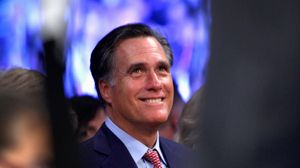When I think about the filming of a documentary, I sometimes picture the person operating the camera as, literally, a fly on the wall; ignored, to varying degrees, by your subjects, with a level of access that allows them to observe things no one else might see. In Greg Whiteley's Mitt, you were that fly on the wall. I'm glad you were able to follow the Romney family through both of Mitt's swings at the Presidential piñata, because during the 2012 elections I often wondered what he was really like. Political candidates always insist that, "what you see is what you get, folks!"--but I never believe them. I was curious to see what Netflix promised would reveal "the man behind the soundbites."
But what we get is pretty much what we would have gotten if he had won the election. Mitt-behind-the-scenes was not all that different from Mitt-in-the-spotlight. During the campaign, I found him distinctly unengaged, often with a glazed-over look in his eyes, as though, in his head, he was somewhere else entirely. In many of the scenes in which Mitt works with his staff, rehearsing talking points or preparing for debates, the situation often devolves into Mitt standing quietly, surrounded by people talking past him and over him while he wears an expression that says, "Where am I and how did I get here?"
This is why Mitt's occasional moments of clarity (honesty?) come as a shock to the system. During an early speech at a campaign event, Mitt acknowledges the fate of failed presidential candidates, saying, "We brutalize whomever loses". He immediately laughs the statement off with his trademark mega-grin, but he seems to have known what he was facing, and I found it to be a compelling moment.
In another scene, Mitt has a meltdown over the increasing accusations, from both his opponent and from the media, about his flip-flopping on key issues. "I'm the flippin' Mormon!" he exclaims. His frustration is downright electric compared to the unflappable, congenial Mitt-bot we were presented with that year. Hand to heart, it was the most animated I have ever seen the man.
Aside from Romney himself, the film focuses heavily on his family. Wife Anne, their five sons, daughters-in-law, and various grandchildren are always close at hand on the campaign trail. More than anything, this is a film about the effect the stress of campaigning has on a candidate's family. Here, there is no discernible difference between the Romneys paraded in front of the electorate and the Romneys behind closed doors. What you see is what you get: a tightly-knit family, deeply protective of their patriarch. While Mitt is the head, Anne Romney is undisputedly its heart, and she and Mitt make a disarmingly sweet couple. (While we're talking about Anne, I have to bring up the slightly alarming moment where she grabs her horse's tongue and cheerfully yanks it around, only because I couldn't help wondering what your face looked like while you were shooting it).
In keeping with the glossy, picture-perfect image voters were shown, there are a number of scenes involving the Romneys discussing the campaign, praying together, or simply hanging out. While there is obvious affection there, there is also a distinct awkwardness. Even the casual family meetings seem stilted or staged. Perhaps this is because it is difficult to be completely natural with a camera in the room. Or maybe the Romneys are as endearingly awkward as late night comedy shows suggested. The frequent rounds of timidly formal back-patting hugs suggest the latter.
The Romney family is pretty much where your "rare behind-the-scenes access" ends. If audiences are looking for any kind of insight into the campaign itself, or on the policies outlined in the Romney-Ryan platform, they're out of luck. When we revisit key moments in the campaign, it's through already-seen footage of debates, speeches, and interviews. The election itself takes place largely in the background. The film touches upon small triumphs, such as Mitt's widely-praised performance in his first debate with Barack Obama, but glosses over the gaffes and missteps that ultimately sank the campaign. We are shown a clip of the infamous "47-percent" video, but no mention is made of how Mitt "liked to fire people," or, to my everlasting disappointment, his "binders full of women." This, again, makes for a certain amount of awkwardness; these moments are elephants in the room.
You didn't show me much about Mitt Romney that I didn't already know. Your fly's-view footage gives us only a slightly better understanding of the man versus the carefully crafted persona-- not enough, unfortunately, to seriously contemplate a world in which he had won the presidency. I started to think about it, but then I watched Candidate Romney try to iron his shirt sleeve while wearing the shirt ("Ouch, that hurts… I think it's working… ouch…") and that was the end of that particular game of 'What If?' Sometimes what the fly sees isn't worth sharing.
Back-patting hugs,
Nat.







